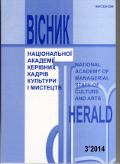А UNITY OF THE ROMANTIC MINIATURES’ CYCLE: AN ART INTROVERSION OF JOHANNES BRAHMS FOUR BALLADES FOR PIANO, OP. 10
DOI:
https://doi.org/10.32461/2226-3209.3.2014.138137Keywords:
piano cycle, piano miniature, ballad, sacredness, introversion, generalization philosophicalAbstract
The article is dedicated to Brahms' cycle "Four ballads for piano op.10" being central of the composer's creative
work early period. The problem of miniature unity in cycle forms of Brahms piano legacy is investigated. The main means the ballads unity into indivisible cycle are revealed such as an aspiration to philosophic generalization, sacredness as a type of figurative mentality, of sense-figurative arches, tone-sensed unity, and method of "sprout" of different themes from the one intonational grain. Johannes Brahms creativity occupies a prominent place in the history of Western music.
Being a representative of the German school of composition, he derived from the tradition of the German classical music and winning of musical romanticism, Brahms put them in his work by a new way and has made a significant contribution to the development of musical art, entering the history of music as late romantic one.
The purpose of this article is to explore the issue of integrity and its cycle of miniatures solutions in the early period of Brahms creativity using "Four Ballades for Piano, Op. 10". The research goal is to implement a comprehensive
musicological analysis of pieces of the cycle to identify its musical and dramatic features, genre and stylistic originality as a cycle of piano miniatures.
Examining Brahms early works, we can conclude that the very first piano works of the young composer impress
us by their deep philosophic creative thinking. Committed to the scale and form of those embodied in the multipart and cycling, the composer showed with starting his first works – piano sonatas (Op. 1, 2 and 5) – and kept in all the periods of his work. "Four Ballades, Op. 10" is psychologically profound, philosophical reflection, generalization in four parts, combined image-specific semantic arches and dramaturgic techniques. Ballads number 1 and number 3 are similar in the minor color. Such sphere contains images of an active action – the middle part of Ballad number 1, the extreme episodes of the second section of Ballad number 2, the first section of the Ballad Number 3, brings cycle into the some features of heroics, militancy, manly harsh strength and strong-willed spirit.
The cycle has two climaxes: an emotional (Ballad number 3) and an intellectual, semantic (Ballad number 4). Intermezzo became one of the favorite genres for Brahms. The composer began to write extensively Intermezzo
from the late seventies. Basically there were some plays of revelation, which developed an intimate type of lyrics,
revealing psychological depth and individuality of human feelings. Composer treats Intermezzo as an independent work for piano miniatures genre. Also, he created the whole cycle of plays – Intermezzo for Piano, which combines different genres such as ballad Capriccio, romance and rhapsody.
From the standpoint of drama, especially noteworthy tonal semantic unity cycle: Ballad number 1 – d-moll, Ballad number 2 are written in the same Major – D-dur. Ballad number 3 – VI is in the key stage on D-dur, as h-moll,
which is also parallel to its tonality. In its turn, the Ballad number 4 completes the cycle tone eponymous majeure with respect to h-moll, that is, H-dur. Consequently, it can be argued that the composer in terms of relations closely related tonalities, moving from one song to another, as if immersed the listener in a single selected by coloristic figurativeemotional sphere, achieving this holistic perception of the work.
One of the clearest means of expression, combining parts of the whole, is the use of syncopated rhythmic patterns. They have the ability to transmit different value and meaning of images. Preservation and transfer of means of musical expression from one work to the next turns the syncopated monorhythm union member in two opposite shaped spheres.
Important factor in the consolidation cycle works is the use of receiving "germination" of different themes from
one grain of intonation by the composer. Among the most important melodic intonation and relationships in the cycle should be highlighted: the first movement harmonic relatives topics Ballad number 2 with the second theme Ballad number 1, intonation and rhythmic similarity between the first and second motifs Ballad number 1, the second motive Ballad number 3 with the second theme Ballad number 1 etc. The commonality of cycle pieces is also apparent in the use of a single composer harmonic language.
The conclusion of our study is that "Ballad op. 10" although belongs to the early works of Brahms, striking skill
and maturity scale of composer’s thinking, his desire for philosophical generalization cycle and persuasiveness of this idea by musical means.
Downloads
Published
Issue
Section
License
Authors who publish with this journal agree to the following terms:
1. Authors retain copyright and grant the journal right of first publication with the work simultaneously licensed under a Creative Commons Attribution License that allows others to share the work with an acknowledgement of the work's authorship and initial publication in this journal.
2. Authors are able to enter into separate, additional contractual arrangements for the non-exclusive distribution of the journal's published version of the work (e.g., post it to an institutional repository or publish it in a book), with an acknowledgement of its initial publication in this journal.
3. Authors are permitted and encouraged to post their work online (e.g., in institutional repositories or on their website) prior to and during the submission process, as it can lead to productive exchanges, as well as earlier and greater citation of published work (See The Effect of Open Access).


